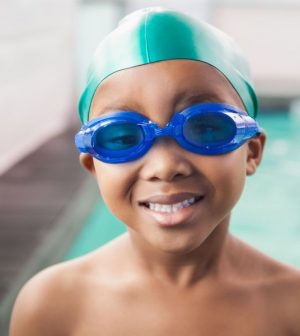- Skip Storing This Everyday Product in the Fridge Door
- Green Tea + B3 Pairing May Boost Brain Health
- Navigating Your Midlife Crisis: Embracing New Possibilities
- City Raccoons Showing Signs of Domestication
- Mapping the Exposome: Science Broadens Focus to Environmental Disease Triggers
- One Week Less on Social Media Linked to Better Mental Health
- Your Brain Changes in Stages as You Age, Study Finds
- Some Suicide Victims Show No Typical Warning Signs, Study Finds
- ByHeart Formula Faces Lawsuits After Babies Sickened With Botulism
- Switch to Vegan Diet Could Cut Your Greenhouse Gas Emissions in Half
Swimming Lessons a Must for Everyone

Swimming lessons can lower the risk of drowning, but black kids often miss out on learning this lifesaving skill, a leading pediatricians group says.
“Everyone should have the opportunity to learn to swim,” said Dr. Kyle Yasuda, president of the American Academy of Pediatrics (AAP).
“This is an essential life skill for children, teens and adults. It’s an important part of the ‘layers of protection’ that families and communities can put in place to protect children and teens around water,” Yasuda said in an AAP news release.
Not everyone has the same access to swimming lessons. Historically, black Americans have faced barriers to learning to swim, and black teen boys have the highest drowning risk of any age group, according to the academy.
Rates of drowning among children aged 11 to 12 are 10 times higher for black kids than for whites, according to the U.S. Centers for Disease Control and Prevention.
According to Dr. Nia Heard-Garris, “This is a problem we can solve.” She is chair of the AAP Section on Minority Health, Equity and Inclusion.
“Some communities have created innovative solutions to provide free or low-cost swim lessons, and others have developed culturally sensitive lessons, and lessons for children with developmental disabilities or special health care needs. All children should have access to these potentially lifesaving skills,” Heard-Garris said.
In 2017, nearly 1,000 children in the United States died of drowning, the leading cause of injury-related death among children aged 1 to 4.
Overall, black children have the highest drowning fatality rates, followed by American Indian/Alaskan natives, whites, Asian American/Pacific Islanders, and Hispanics.
Dr. Benjamin Hoffman is chair of the AAP Council on Injury, Violence & Poison Prevention. He said, “Drowning is fast, silent, and can happen even when it is not swim time. It happens to real families, families with good, attentive parents who never thought it could happen to them. I can’t emphasize enough how important it is to have many layers of protection to prevent drowning.”
Along with learning to swim, those layers of protection include close and constant supervision of children when they’re in and around water, pool fencing, learning CPR, and wearing life jackets when in open water or on watercraft, the AAP says.
More information
The American Academy of Pediatrics has more on drowning prevention.
Source: HealthDay
Copyright © 2025 HealthDay. All rights reserved.










